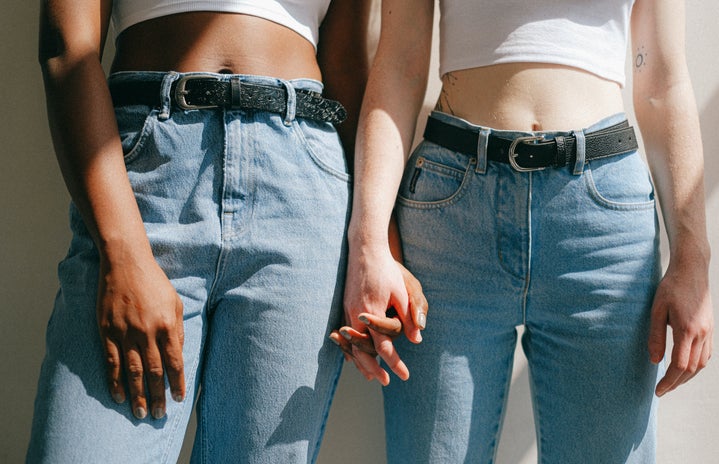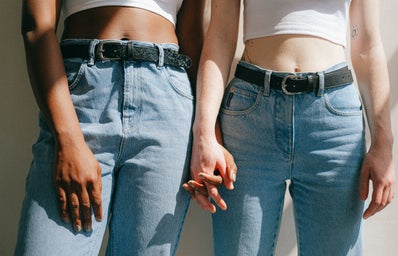Throughout time, queer bodies, as well as queer people themselves, have been heavily sexualised. Even within the law, sexual acts were and are often made legal before marriage, insinuating that queer relationships are not for life, and that they are unserious. With growing acceptance of the LGBTQIA+ community, especially in the UK, queer people are mostly able to live like their heterosexual counterparts freely. However, as a queer woman myself, there are still normalised acts and phrases that sexualise and outcast queer identities. So, here is my experience with the general public as an overtly bisexual woman whose appearance outwardly presents as extremely queer.
The centrality of sex
As well as in the eyes of the law, sex is also seen as impartial to transgender people as their genitalia is hyper-fixated upon in the public eye. Within society, to be able to enter a woman’s bathroom as a trans woman you must have gender affirming surgeries, and vice versa in regard to trans men. Non-binary people are also constantly disregarded, as most of society disagree with gender neutral bathrooms. Therefore, in order for trans men and trans women to feel wholly comfortable in themselves and be accepted within the world, it is expected of them to alter their bodies to conform to societal norms. Genitalia is deemed as one of the defining traits of a persons gender, when in reality, gender should simply be what a person defines themselves as. Even our Prime Minister, Rishi Sunak, is openly transphobic as he made a “joke” about Keir Starmer “defining a woman” with Brianna Ghey’s (a girl who was murdered for being transgender) mother Esther watching from the gallery. The complete dismissal in the eyes of the law and society of trans people without gender affirming surgeries is unacceptable, and intimate, private things like ones genitalia should not be the defining factor of ones gender or position within society.
The sexualisation of queer women is a topic which is so underrepresented, and it makes me sick to my stomach. Lesbian and bisexual women are mostly seen as objects for men’s desire, especially regarding lesbian pornography. Lesbian pornography is produced by men, for men, giving society the impression that those who identify as a woman and love other women do so for the male gaze. This was made evident in the 2019 London bus attack, in which a lesbian couple were harassed and told to kiss each other, in which they refused and were viciously beat up for it. Constantly being asked to kiss by men, being asked for threesomes by men and being told a man could “turn them straight” is a normal day for a lesbian due to the sexualisation of their queer bodies. Their identities are misinterpreted as something owned by and made for men, which is vile and inappropriate. Lesbian relationships are pure and beautiful, and definitely just for wlw.
My sexualisation: “Shipping” culture
Since the rise of the internet and television, the public (young people especially) have begun ‘shipping’ their favourite characters. Whether that be from a book, a TV show or a video game, any character would be shipped with another no matter their gender or sexual identity. However, this playful culture had a toxic side, where some people would ‘ship’ real humans, even if they were only close friends. The reason I mention this is not to deep dive into the way the “Phandom” terrorised and tortured the YouTubers Dan and Phil to come out of the closet for years (although that is a great example), I am speaking from personal experience.
My best friend and I, we’ll call them X, both look, to put it simply, quite gay. We both identify as queer, but have never and will never have a romantic or sexual relationship. We are platonic soulmates, and that is all. However, because I would regularly post on social media with them, and because my ex and I were best friends first, a lot of people began to assume that we were dating. Assumptions are okay, but a lot of acquaintances started commenting on BeReals or Snapchat stories I’d post, telling me X was going to be my ‘wife’, and that X and I were definitely ‘secretly together’. All of this was untrue, and made us hesitant to show ourselves together online, as it came with a barrage of harassment. They would not take no for an answer. We were ‘shipped’ together by people who actually knew us just for being friends whilst looking and being gay. X and I, to this day, still have to convince many people that we aren’t together because we are an outwardly looking queer duo.
This experience was disgusting and damaging for both X and I, but our friendship is still, and always will be, going strong. Forcing two queer people together or to come out of the closet should not be normalised within our society, and ‘shipping’ culture has twisted into a toxic and harmful “joke”. Queer people CAN be friends.
Leave queer people alone.
The LGBTQIA+ community is one that I hold close to my heart, and will always defend with the upmost respect. The circumstances for queer people are extremely different nowadays and that is something I will be eternally grateful for. However, a lot of the instances I’ve brought to light are being brushed under the rug, and for the safety and comfortability of queer identities in society, change still needs to occur. It’s time to stop sexualising queer identities and see queer people for who they truly are: humans.


